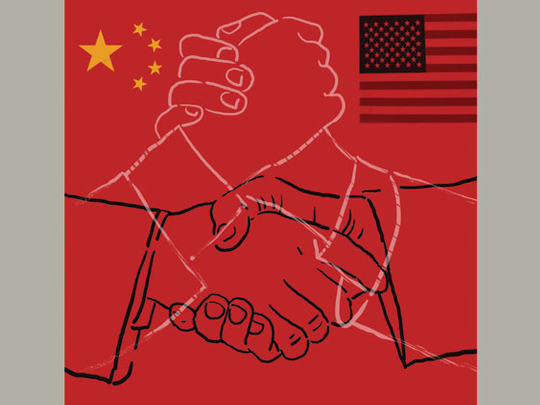
The ‘Sunnylands summit’, which brought together Chinese President Xi Jinping and US President Barack Obama at a California estate on the weekend, may prove to be a watershed in relations between the world’s largest and second-largest economies. Indeed, what Xi wants from the meeting — namely, “a new type of relationship between major powers” — has its conceptual origins in the historic meetings between Mao Zedong and Richard Nixon in 1972.
In 1969, the newly elected Nixon’s gravest challenges were ending the Vietnam War and coping with an increasingly aggressive Soviet Union. China was pivotal to Nixon’s grand scheme to resolve these seemingly intractable problems.
Indeed, China played a special role in assisting North Vietnam against the Americans, and its relations with the Soviet Union were souring to the point of violent skirmishes along their shared Amur River border. Nixon and his national security adviser, Henry Kissinger, sensed that it was time to restore relations with China, which also feared the Soviets’ hegemonic ambitions. Nixon and Kissinger circumvented the US State Department and Congress and established contacts with China via clandestine channels in Pakistan and Romania.
Over the next three years, the two countries managed to overcome their ideological differences to reach a working compromise on the Soviet Union, Vietnam, and even Japan, while ensuring that the “Taiwan question” did not become a source of harm to both countries’ real interests as they moved to improve relations. With these agreements outlined, Nixon visited China in February 1972, a trip that ended with the signing of one of the twentieth century’s most important diplomatic documents, the “Shanghai Communiqué”.
If the Sunnylands summit is to yield long-term benefits of the sort that the Mao-Nixon summit did, it must be pitched at the same philosophical and strategic level. Sino-American relations are, of course, far more sophisticated than they were in 1972, given the two countries’ deep economic ties. So we should hope for a “California Communiqué” that can establish a path for bilateral relations in the coming decades.
The goal for Obama and Xi must be to prevent their countries’ current “competitive coexistence” from devolving into strategic confrontation — something that no established power and rising power have ever managed to do. Despite both leaders’ reiteration of the importance of a stable, positive, and collaborative relationship, strategic competition will continue to grow as China’s economy catches up with and surpasses America’s (at least in GDP terms) in the coming years.
So the objective in Sunnylands must be to lay the groundwork for rules that prevent the alleged Sino-American rivalry from boiling over. However suspicious of the other’s long-term strategic intentions each side may be, a non-confrontational relationship is the only viable choice for both countries. Unfortunately, the current drift in bilateral relations is highly risky in this regard.
What can bind China and the US together, given that the shared Soviet threat no longer exists, and that a considerable part of both countries’ elites regard the other side as the main source of danger?
Strategic planners in Beijing and Washington must look beyond traditional threats and focus on issues like economic stability, resource and energy security, technological advancement, climate change, demographic challenges, and cybersecurity. These are issues that cannot be resolved by one country alone or by simply marshalling one’s allies. They pose a threat that is bigger than the former Soviet Union, is certainly more complex, and that can be met only through cooperation.
For example, China is already the world’s largest energy consumer and the largest emitter of carbon dioxide. Both countries have suffered from extreme weather events in recent years. Even if shale gas soon makes the US energy-independent, it cannot afford the global impact of other countries consuming, polluting, and emitting heavily.
Similarly, cybersecurity, a new topic in the bilateral relationship, is likely to be a touchy issue — but one that both sides have a strong interest in addressing cooperatively. The same is true of efforts to prevent the situation on the Korean peninsula from worsening, to ensure stability in Afghanistan and Pakistan, to resolve the Middle East conundrum, and to create an open and inclusive structure for regional and global trade and investment. Building a new type of military-to-military relationship must also be among the most important outcomes of the Sunnylands summit.
If the meeting between Mao and Nixon 41 years ago began to thaw a frozen relationship, the meeting between Xi and Obama has the potential to reshape what has since become the world’s most important bilateral relationship — and prevent the need for any future thaw.
Four decades ago, what brought China and the US together was something they both opposed. What brings them together today must be something that they both want.
Both countries know that it is time to cooperate and shape the future. Only by demonstrating strategic restraint and political will to resolve issues and get things done can they face their common challenges together and successfully.
— Project Syndicate, 2013.
Minghao Zhao is a research fellow at the China Center for Contemporary World Studies, the think tank of the International Department of the Central Committee of the Communist Party of China. He is also the executive editor of China International Strategy Review and a non-resident fellow at the Centre for International and Strategic Studies, Peking University. Junli Zheng is a research fellow at the China Centre for Contemporary World Studies.










